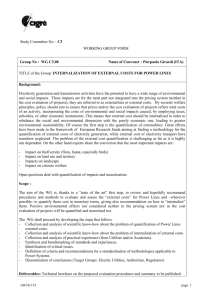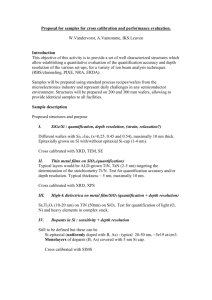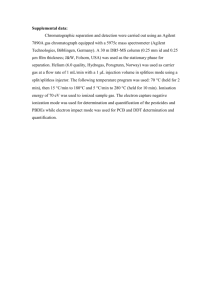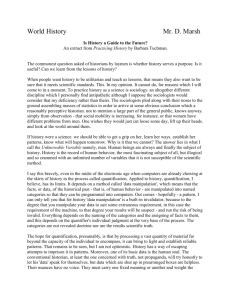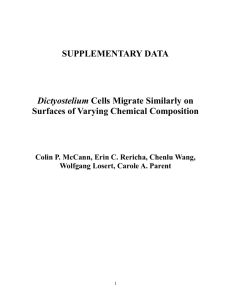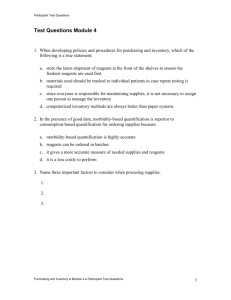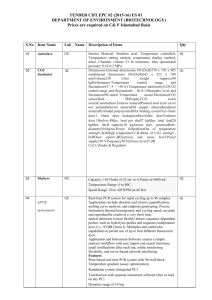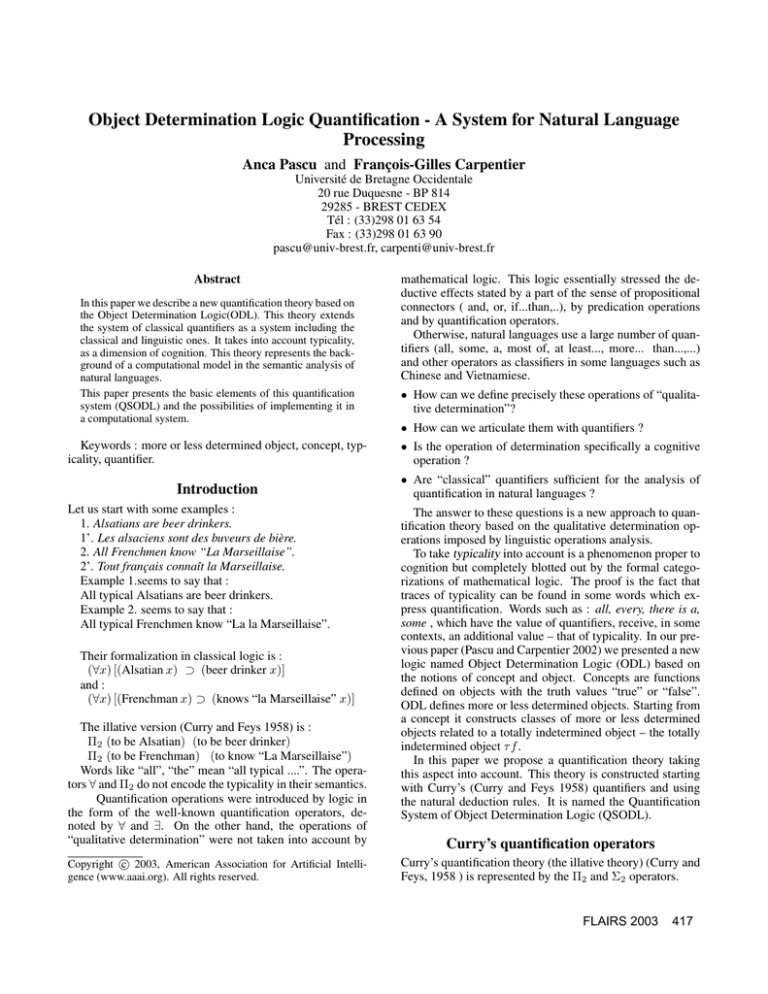
Object Determination Logic Quantification - A System for Natural Language
Processing
Anca Pascu and François-Gilles Carpentier
Université de Bretagne Occidentale
20 rue Duquesne - BP 814
29285 - BREST CEDEX
Tél : (33)298 01 63 54
Fax : (33)298 01 63 90
pascu@univ-brest.fr, carpenti@univ-brest.fr
Abstract
In this paper we describe a new quantification theory based on
the Object Determination Logic(ODL). This theory extends
the system of classical quantifiers as a system including the
classical and linguistic ones. It takes into account typicality,
as a dimension of cognition. This theory represents the background of a computational model in the semantic analysis of
natural languages.
This paper presents the basic elements of this quantification
system (QSODL) and the possibilities of implementing it in
a computational system.
mathematical logic. This logic essentially stressed the deductive effects stated by a part of the sense of propositional
connectors ( and, or, if...than,..), by predication operations
and by quantification operators.
Otherwise, natural languages use a large number of quantifiers (all, some, a, most of, at least..., more... than...,...)
and other operators as classifiers in some languages such as
Chinese and Vietnamiese.
• How can we define precisely these operations of “qualitative determination”?
• How can we articulate them with quantifiers ?
Keywords : more or less determined object, concept, typicality, quantifier.
• Is the operation of determination specifically a cognitive
operation ?
Introduction
• Are “classical” quantifiers sufficient for the analysis of
quantification in natural languages ?
Let us start with some examples :
1. Alsatians are beer drinkers.
1’. Les alsaciens sont des buveurs de bière.
2. All Frenchmen know “La Marseillaise”.
2’. Tout français connaı̂t la Marseillaise.
Example 1.seems to say that :
All typical Alsatians are beer drinkers.
Example 2. seems to say that :
All typical Frenchmen know “La la Marseillaise”.
Their formalization in classical logic is :
(∀x) [(Alsatian x) ⊃ (beer drinker x)]
and :
(∀x) [(Frenchman x) ⊃ (knows “la Marseillaise” x)]
The illative version (Curry and Feys 1958) is :
Π2 (to be Alsatian) (to be beer drinker)
Π2 (to be Frenchman) (to know “La Marseillaise”)
Words like “all”, “the” mean “all typical ....”. The operators ∀ and Π2 do not encode the typicality in their semantics.
Quantification operations were introduced by logic in
the form of the well-known quantification operators, denoted by ∀ and ∃. On the other hand, the operations of
“qualitative determination” were not taken into account by
c 2003, American Association for Artificial IntelliCopyright gence (www.aaai.org). All rights reserved.
The answer to these questions is a new approach to quantification theory based on the qualitative determination operations imposed by linguistic operations analysis.
To take typicality into account is a phenomenon proper to
cognition but completely blotted out by the formal categorizations of mathematical logic. The proof is the fact that
traces of typicality can be found in some words which express quantification. Words such as : all, every, there is a,
some , which have the value of quantifiers, receive, in some
contexts, an additional value – that of typicality. In our previous paper (Pascu and Carpentier 2002) we presented a new
logic named Object Determination Logic (ODL) based on
the notions of concept and object. Concepts are functions
defined on objects with the truth values “true” or “false”.
ODL defines more or less determined objects. Starting from
a concept it constructs classes of more or less determined
objects related to a totally indetermined object – the totally
indetermined object τ f .
In this paper we propose a quantification theory taking
this aspect into account. This theory is constructed starting
with Curry’s (Curry and Feys 1958) quantifiers and using
the natural deduction rules. It is named the Quantification
System of Object Determination Logic (QSODL).
Curry’s quantification operators
Curry’s quantification theory (the illative theory) (Curry and
Feys, 1958 ) is represented by the Π2 and Σ2 operators.
FLAIRS 2003
417
These operators are defined by the following rules of introduction and elimination:
For Π2 :
(f x)
..
.
[ i - Π2 ]
(g x)
Π2 f g
Π2 f g, (f x)
(g x)
[ e - Π2 ]
For existential quantification :
f g : Etendue f ∩ Etendue g = ∅
Σstrong
2
Σweak
f
g : Extf ∩ Ext g = ∅
2
Note :
≡ Π2 and Σweak
≡ Σ2
Πweak
2
2
and
Πstrong
f g =⇒ Πweak
fg
2
2
strong
weak
Σ2
f g =⇒ Σ2
fg
¿From the cognitive point of view the interpretation of
two operators can vary between a lower limit (given by Ext)
and an upper limit (given by Etendue). There are no epistemical means of proving the cognitive adequation of one or
of the another.
For Σ2 :
A new quantification theory
Π
(f a) ∧ (g a)
Σ2 f g
[i - Σ2 ]
Σ2 f g, (f a) B, (g a) B
B
[ e - Σ2 ]
with their semantics :
Π2 f g : Extf ⊂ Extg says that : all the objects falling
under f fall under g as well . The extension of the concept
f , Ext f is the class of all totally determined objects falling
under f .
Σ2 f g : Extf ∩ Extg = ∅ says that : there is at least an
object falling simultaneously under f and g .
A new semantics
In the paper (Pascu and Carpentier 2002) we defined classes
Etendue(f ) and Etendue(τ f ). The first one is the class of all
objects (more or less determined) falling under f ; the second
one represents all more or less determined objects which can
be constructed starting from τ f . The object τ f is the totally
indetermined object associated to the concept f .
If we make the following hypothesis (very strong) that
“everything that is constructible is also deductible” and conversely, that is :
Etendue(τ f ) = Etenduef
Then the following relations hold :
1. Etendue
⊂ Ext g
f ⊂ Etendue g =⇒ Ext f 2. Ext f Ext g = ∅ =⇒ Etendue f Etendue g = ∅
These relations show that the following statements are not
equivalent :
“ All totally determined objects of f are totally determined objects of g.”
and
“All objects of f are objects of g. ”
This idea determines the definition of two Π2 operators : a strong universal quantification operator denoted by
) and a weak universal quantification operator de(Πstrong
2
noted by (Πweak
):
2
Πstrong
f
g
:
Etendue
f ⊂ Etendue g
2
f
g
:
Ext
f
⊂
Ext
g
Πweak
2
418
FLAIRS 2003
and
Σ
operators
A cognitive dimension to interprete quantification operators
is typicality. A typical object is an object x obtained from
τ f by applying only determinations “typically compatible
with f ”(Pascu and Carpentier 2002).
This new theory of quantification is represented by a system of quantifiers larger than the traditional one.
There are two problems when the Π2 operator is defined:
• This operator must be applied to the nominal phrase and
not to the entire clause. This constraint is issued from the
Subject-Predicate linguistic structure of the clause.
• This operator must take typicality into account.
We consider the predicate T Y P IQU E(f )(x) which
means : x is a typical object of f . We introduce the typical universal quantification operator.
• The introduction-elimination rules for the Π operator
(typical universal quantification operator) are :
T Y P IQU E(f )(x), (f x) (gx)
g(Π f )
or
T Y P IQU E(f ) (x)
(f x)
..
.
[ i- Π ]
(g x)
g(Π f )
If x is a typical object generated from τ f and if from (f x)
one can deduce (g x), then g(Π f ).
g(Π f ), T Y P IQU E (f ) (x), (f x)
[ e - Π ]
(g x)
If g(Π f ), (f x) and x is a typical object generated from
τ f then (g x).
g(Π f ) is read : every typical object of f is an object of
g, abbreviated every typical f is g.
For existential quantification we introduce Σ and we
change the semantics of this quantifier as follows.
• The introduction-elimination rules for the existential
quantification operator Σ are :
(f a) ∧ (g a)
g(Σ f )
[ i - Σ ]
g(Σ f ), (f a) B, (g a) B
B
[ e - Σ ]
• The introduction-elimination rules for the typical existential quantification operator Σ2 are :
T Y P IQU E (f ) (a), (f a) ∧ (g a)
Σ2 f g
[ i - Σ2 ]
T Y P IQU E (f ) (a), Σ2 f g, (f a) B, (g a) B
[e - Σ2 ]
B
g(Σ f ) is read : there is a f which is g.
Σ2 f g is read : there is a typical f which is g.
A first asymmetry between Π and Σ is due to the asymmetry of Π in f and g and to the symmetry of Σ in f and
g:
(∀x)((f x) ⊃ (gx))
(∃x)((f x) ∧ (gx)) or
(∃x)((gx) ∧ (f x))
This asymmetry generates the second asymmetry between
operators Π et Σ as regards typicality : what is the operator
which includes typicality between Π2 and Π , and between
Σ2 and Σ ?
The change of semantic features as regards typicality between Σ2 and Σ is a hypothesis derived from the fact that
one proves the existence of an object by giving an object
construction. But construction generally leads to typical objects and not to atypical ones. Applying Σ to f , one states
the existence of an object falling under f (not necessarily
typical). The proof of g(Σ f ) is the construction of an object (typical or not) falling under f and verifying g. The
proof of Σ2 f g is a typical object of f verifying g.
The system of these four quantifiers gives a cube on the
model of Aristotle’s square (fig.1).
Examples
There are traces of typicality in natural languages. These
traces are expressed explicitly or not in the syntax, but there
is always a degree of semantic ambiguity which cannot be
solved either at clause level or at context level. We present
some examples which can be formalized by quantifiers in
our system.
Π2 operator
The Π2 operator is a quantifier which allows us to formalize
mathematical propositions universally quantified and general statements from common language. It is expressed in
English by “all”, “the”, “a”, but also by “every”. It can be
expressed by locutions as “all without exception”, “absolutely all”....
1. Every man is mortal.
Π2 (to be a man)(to be mortal)
2. All men are mortal.
Π2 (to be a man)(to be mortal)
Example 1 can be interpreted by :
(to be mortal)(τ (to be a man))
Example 2, because of the plural has rather the interpretation of a Π2 .
3. Man is mortal.
can have two interpretations :
Π2 (to be a man)(to be mortal)
(to be mortal)(τ (to be a man))
4. All Frenchmen drink wine.
Π2 (to be Frenchman)(to be a wine drinker)
In example 4 the pronoun “all” gives the sense of Π2
rather than Π .
Π operator
Π operator is the quantifier which allows the formalization
of sentences from common language with predications of
typical objects. It is encoded in natural language in the same
way as Π2 (without giving the typicality). Sometimes, it
is expressed by expressions as : “with some exceptions”,
“generally”.
5. Every Alsatian drinks beer. (G. Kleiber)
(to be beer drinker) (Π (to be Alsatian))
6. An Alsatian drinks beer.
(to be beer drinker) (Π (to be Alsatian))
or
(to be beer drinker) (τ (to be Alsatian))
7. Frenchmen drink wine.
(to be wine drinker)(Π (to be French))
Σ operator
This operator allows the formalization of a sentence containing an existential quantifier. It is encoded by “a, (an)”, “there
is a, (an)”, “there are”, “it exists a”.
8. A thief stole my bag. (Un voleur m’a dérobé mon sac)
(to steal the bag of...)(Σ (to be a thief))
A particular totally undetermined human being stole my
bag. The word “thief” expresses here a totally undetermined
object.
9. There are students who arrive late for my class.
(to be late in the class of...)(Σ (to be student))
There is at least one student (typical or not) who arrives
late for my class.
10. There is a prime number which is even
(to be even)(Σ (to be a prime number))
FLAIRS 2003
419
Σ2 operator
This quantifier allows the formalization of clauses from
common language containing an existential quantification of
typical objects.
11. There are birds which glide well in the wind.
Σ2 (to be a bird)(to glide well in the wind)
12. There is a continuous function which is not derivable
Σ2 (to be a continuous function)(to be non-derivable)
There is at least one continuous function which is nonderivable and this function is a typical one versus these two
properties.
A proposition for a new generalized theory
There are other cognitive processes like counting or numerical estimation which are often considered as quantification
in linguistics. The relation between quantification in logic
and that in linguistics can generate a unification of the two
approaches. We will try to sketch it.
We start from the following question :
• Is it legitimate to consider all determiners as quantifiers as
Keenan say (Keenan,1997) ?
First of all, it can be noted that qualification and quantification as cognitive operations are characterized by :
• to construct classes of objects starting from object properties — for the first one
• to construct classes of objects starting from other classes
by comparing their dimensions — for the second one.
They are different and their operators must be different.
Moreover a generalized quantifier in Keenan’s sense is not
a quantifier in the sense of logic.
We propose the following distinctions :
• Qualification applies a determination or a string of determinations to an object (more or less determined). It results in another object more determined than the initial
one :
y = (∆ x)
It is applied to objects.
• Quantification applies a quantification operator ( Π2 , Σ2 ,
Π , Σ ,..) to a concept f . It results in the statement of
a relation between Etendue(τ f ) and another class of objects.
• Other “counting” operations expressed by applying a
“counting operator” to a concept f . It always results in
the statement of a relation between classes of objects.
“Counting” operators are very particular. Most of the determiners described by Keenan are “counting operators”.
Conclusions
Quantification is a cognitive process which allows the determination of the denotative scope of a concept.
• Are there objects falling under a concept ? If so, is there
one or more ?
• Do all objects from the universe of discourse fall under
this concept or not?
420
FLAIRS 2003
The quantification of classical logic is not sufficient to express typicality. A larger system of quantifiers is defined.
The features of it are :
• It is based on the categorization system of ODL (Pascu
2001)
• This system takes typicality into account.
We are working with a system which can find the typicality of objects expressed in a text.
References
Curry H.B. and Feys R. eds. 1958. Combinatory Logic vol
I., North Holland.
Desclés J.-P. 1999. Opérations de qualification et quantification dans les langues naturelles. In Les Opérations
de Détermination – Quantification, Qualification, 13-44,
Ophrys, Paris – Gap, Deschamps Guillermin-Flesher.
Keenan E. L., 1997. Generalized Quantifiers in Linguistics
and Logic. In Handbook of Logic & Language J. Van Benthem and A. Ter Meulen eds., North Holland.
Pascu A. 2001. Logique de la Détermination d’Objets : concepts de base et mathématisation en vue d’une modélisationobjet. Ph.D. thesis, Université de Paris IV (Paris-Sorbonne).
Pascu A. and Carpentier F-G. 2002. Object Determination
Logic-A Categorization System. In Proceedings of the Fifteenth International Florida Artificial Intelligence Research
Society Conference, 178-180, Florida, 2002.
Every f is g
Π2 f g
No f is g
Π2 f (N1 g)
A
A
A
A
A
A
A
A
A
g(Π f )
?
A
Every typical f is g A
(N1 g)(Π f )
?
No typical f is g
A
A
A
A
A
A
A
A
A
?
There is a typical f
which is g
Σ2 f g
A
A
?
A
A
A
A
There is a typical f
which is not g
Π2 f (N1 g)
A
A
A
A
A
A
g(Σ f )
There is a f which is g
A
A
(N1 g)(Σ f )
There is a f which is not g
Figure 1: Quantifier’s cube
FLAIRS 2003
421

